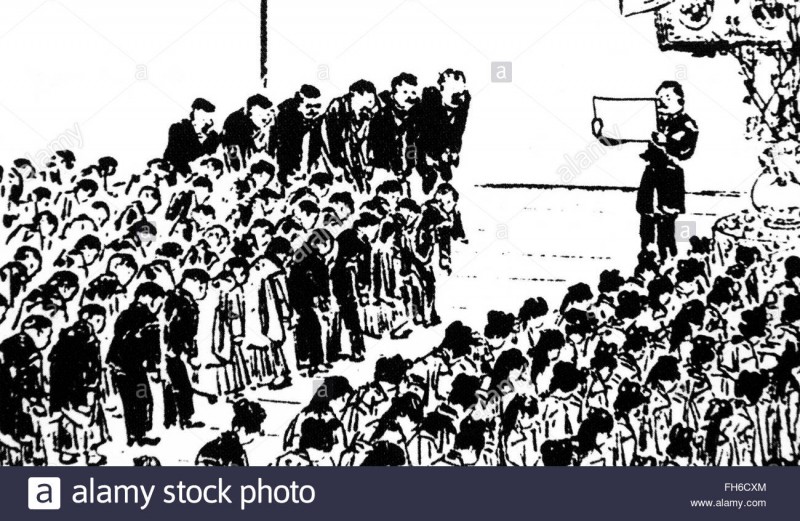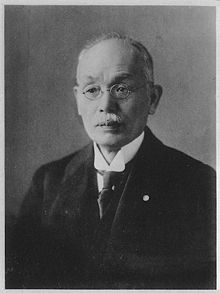There are moves in certain ruling circles to reintroduce the Imperial Rescript on Education of 1890, which became one of the pillars of State Shinto before the war. It’s a complex issue, and Green Shinto friend Shaun O’Dwyer recently wrote an article for the Japan Times explaining the historical background. The following is an abridged version of the original article.
(Shaun O’Dwyer is an associate professor in the School of Languages and Cultures, Kyushu University, and is completing a book on the prospects for modern Confucianism.)
**************
FUKUOKA – The Imperial Rescript on Education, a short founding document of modern Japanese nationalism first issued to Japan’s schools by the Education Ministry in 1890 and banned from official use in 1948, has been in the news lately. There has been a scandal over Osaka school operator Moritomo Gakuen’s questionable dealings with government officials to get a sweetheart deal on state land for a new school. There were shocking revelations about the anti-Chinese and anti-Korean xenophobia of the operators. Yet for conservative nationalists like Defense Minister Tomomi Inada, the reaction to the latter revelation was “what’s so bad about the Imperial Rescript anyway?”

Reading of the Imperial Rescript at morning assembly in school
While liberal newspapers have underlined its affiliations with the pre-1945 emperor-centered State Shintoism, it is also a strikingly Confucian document. Emperor Meiji exhorts his subjects to practice the morality associated with the “five human relations” of the ancient Confucian text the “Mencius”: to be filial to parents, affectionate to siblings, true to friends, harmonious as spouses and so forth. And the Emperor speaks of his subjects “ever united in filial piety and loyalty,” two cardinal Confucian virtues. Conservatives have affirmed these homely moral elements of the rescript, arguing that the “spirit of the rescript” merely aims to make Japan a moral nation.
Historical background: ‘Kokutai’
The idea of the kokutai, or national polity, was originally developed by Mito Academy scholars in the early 19th century. Reinterpreting old Shinto myths of an unbroken, single line of emperors stretching back to the Sun Goddess Amaterasu, the Mito scholars wrote of how Japan could be united in loyalty and filial piety through rites-based veneration for ancestors and for the emperor.
In such rites the emperor filially venerates his ancestors and the Sun Goddess herself, and the people filially venerate their ancestors, who had themselves loyally served and venerated the emperor’s ancestors. The kokutai was a ritual-political order in which the people united in filial piety and loyalty under the emperor without the need for force.
The Meiji Constitution, also enacted in 1890, invokes the sacredness of the emperor and his ancestors, comprising the “line of emperors, unbroken for ages eternal”. This all looks conservative and weirdly mythical, but it need not have led to fascism. To understand why, we need to introduce another Meiji era intellectual largely forgotten today, but who towered over early 20th century Japanese scholarly and educational life; Tetsujiro Inoue, a professor of philosophy at the University of Tokyo.

Tetsujiro Inoue, 1855-1944
Tetsujiro Inoue
Inoue was a competent scholar and a very able propagandist. In 1891, under the direction of the Education Ministry he wrote a highly influential school textbook commentary for the Imperial Rescript on Education, and he would write much more on behalf of the ministry in coming decades.
Inoue helped rally public opinion against dissenters who “endangered the kokutai”; a Christian school teacher who did not bow before a copy of the rescript in a school ceremony in 1890, or historians who publicly questioned the veracity of the “eternal, unbroken imperial line”, intimidating them into silence.
He helped theorize a “national morality” unique to Japan, which the rescript supposedly expressed in compressed form. This national morality was cobbled together from his notions of an indigenous bushido morality, a Japanized Confucianism, Buddhism and German philosophical ideas of “national spirit” or “volksgeist.”
Ideas like this would go on to become the common sense of the more extreme nationalism and imperialism that prevailed in the 1930s. Japan’s superior, unique national morality was believed to entitle it to a position of moral leadership over other Asian countries. As Japanese armies rampaged through China, Inoue asserted that Japan’s moral mission there was to help the Chinese recover their true national morality — Confucianism — under Japanese tutelage.
– by Shaun O’Dwyer Japan Times 20/3/2017.
[For recent moves to legitimise use of the imperial rescript in schools, see this article.]
[For examples of how the government is pushing education back to prewar indoctrination, see here.]
[For an overview of the slow legitimation of the imperial rescript, see this JT article.]
(For an article about the anger arising from Abe’s attempt to revive prewar politics, see this article.]
[Article on how Abe is leading the country towards fascism: see this link here.
‘The once-revered Imperial Rescript on Education, issued in 1890, was abolished after Japan’s World War II defeat at the hands of the U.S. over concerns it had contributed to creating a militaristic culture. It exhorted citizens to “offer yourselves courageously to the State” so as to “guard and maintain the prosperity of Our Imperial Throne”.’

Leave a Reply